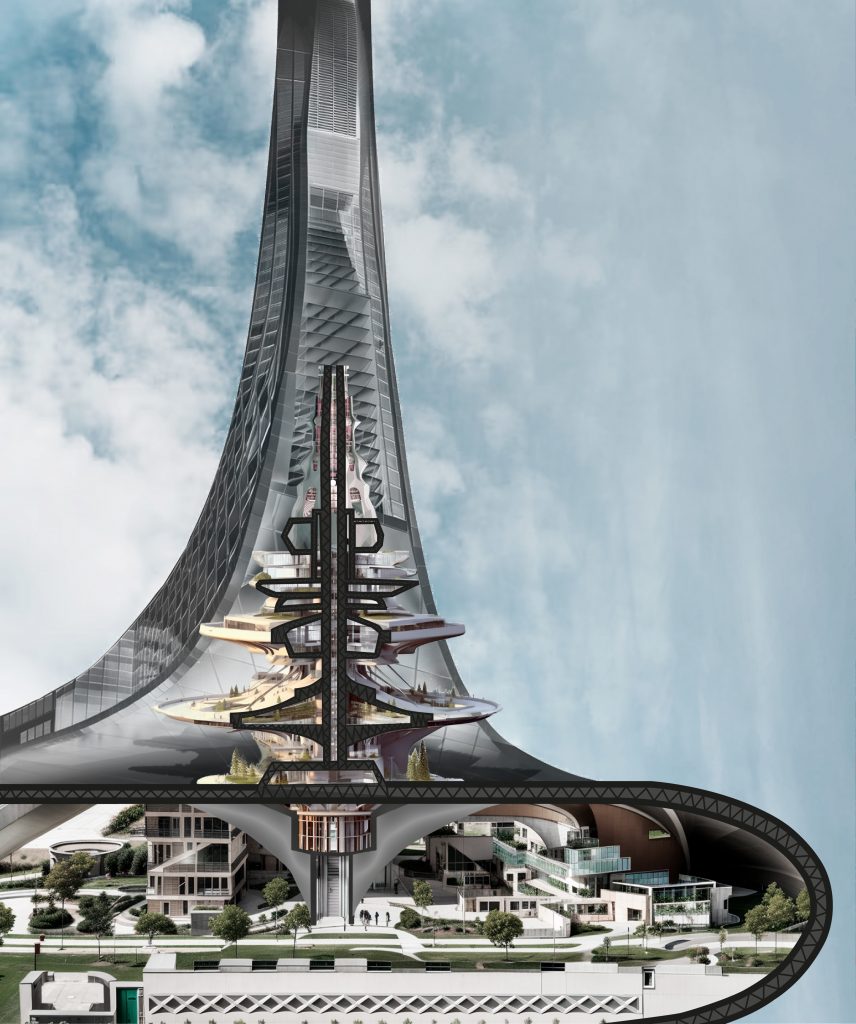The project is developed in 7 different scales: body, interior, building, city, territory, planetary, interscalar. We believe that a proposal that encompasses different areas individually and then considers how they all fit together is ideal for thinking about quality of life for everyone.
The proposal of this project is based on a profound understanding of the interconnection among the different elements of Earth and its intrinsic capacity for self-regulation to maintain environmental balance. Recognizing the biosphere’s ability, it is suggested to address the climate crisis through urgent adaptation to the inevitable changes we face.
With the guiding principle of “Think globally, act locally,” the project seeks to understand how actions at different scales, from planetary to corporal, interact and influence each other in the context of climate change. The need for comprehensive adaptation that considers multiple levels of action and their interconnection to effectively address challenges is acknowledged.
The global masterplan encompasses survival, mitigation, and regeneration plans to effectively address challenges. In the survival plan, the proposal includes the construction of a flying ring that will serve as a central platform for the implementation of various urban and community initiatives. This ring will act as a connection point between different city stations and sectors, facilitating residents’ access and mobility.
Within the ring, various vital facilities and services will be located, including housing, educational spaces, recreation areas, research and development centers, among others. These facilities will be designed following sustainability and energy efficiency principles, utilizing innovative technologies to maximize their operation and minimize their environmental impact.
Furthermore, the flying ring will serve as a platform for implementing urban regeneration projects and enhancing the surrounding natural environment. The creation of green spaces and natural areas within and around the ring is envisioned, promoting biodiversity and resilience of urban ecosystems.
In the mitigation plan, the other ring, the ground ring, plays a fundamental role in the regeneration of the natural environment and sustainable resource management. This ring is designed to harness renewable energies and promote responsible environmental practices in the city.
One of the main functions of the ground ring is energy generation from renewable sources such as wind, solar, and geothermal energy. Renewable energy plants and devices will be installed in different areas of the ring, leveraging climatic and geographical conditions to maximize efficiency.
In addition to energy generation, the ground ring will also host facilities for air and water purification, as well as soil regeneration. Filtration and treatment systems will be implemented to remove pollutants and improve air and water quality in the city.
Another important function of the ground ring is waste management and promotion of recycling and material reuse. Advanced recycling plants and waste sorting centers will be established to reduce the amount of waste sent to landfills and foster a circular economy.
Moreover, the ground ring will act as a research and development center for innovative environmental technologies. Studies and experiments will be conducted to improve environmental management practices and find sustainable solutions to the city’s environmental challenges.
The final stage of the plan is regeneration. Ecosystem restoration is addressed using genetic mutation tools and decarbonization technologies to promote environmental regeneration and mitigate the effects of climate change.
On one hand, genetic mutation is used to enhance the resistance and adaptability of plant species to changing environmental conditions. Techniques such as genetic modification are explored to create plant varieties more resistant to drought, soil salinity, or diseases, allowing their reintroduction into degraded ecosystems and facilitating their recovery.
Furthermore, genetic mutation can be employed to restore biodiversity and promote the recovery of endangered species. The possibility of reintroducing beneficial genetic variants into depleted populations is being investigated, as well as strengthening the genetic diversity of existing populations to increase their adaptability and survival capacity.
On the other hand, decarbonization technologies are used to eliminate or reduce carbon emissions in the environment and promote carbon capture and storage in natural ecosystems. This may include the implementation of air purification systems based on biological processes, such as artificial photosynthesis or carbon absorption by marine organisms.
Likewise, environmental remediation methods that use genetically modified microorganisms to break down contaminants and remove toxins from soil and water are being explored. These technologies can contribute to the recovery of degraded ecosystems and the restoration of environmental quality in areas affected by industrial pollution or human activity.
Together, the application of genetic mutation techniques and decarbonization technologies in ecosystem restoration offers an innovative and promising approach to addressing current environmental challenges and promoting long-term sustainability. By harnessing the potential of biotechnology and environmental engineering, the aim is to drive ecosystem regeneration and mitigate the impacts of climate change on the planet.
In response to this situation, it is imperative to adopt urgent and effective measures to mitigate the effects of climate change at different life scales and adapt to an increasingly uncertain future. In addition to the immediate impacts on the environment and society, climate change is also exacerbating existing problems such as poverty, inequality, and food insecurity, further aggravating the situation.
Government Agencies
Scientific Community
Businesses and Industry
Communities and Residents
International Organizations
Technology Providers
Financial Institutions
Civil Society and Advocacy Groups








